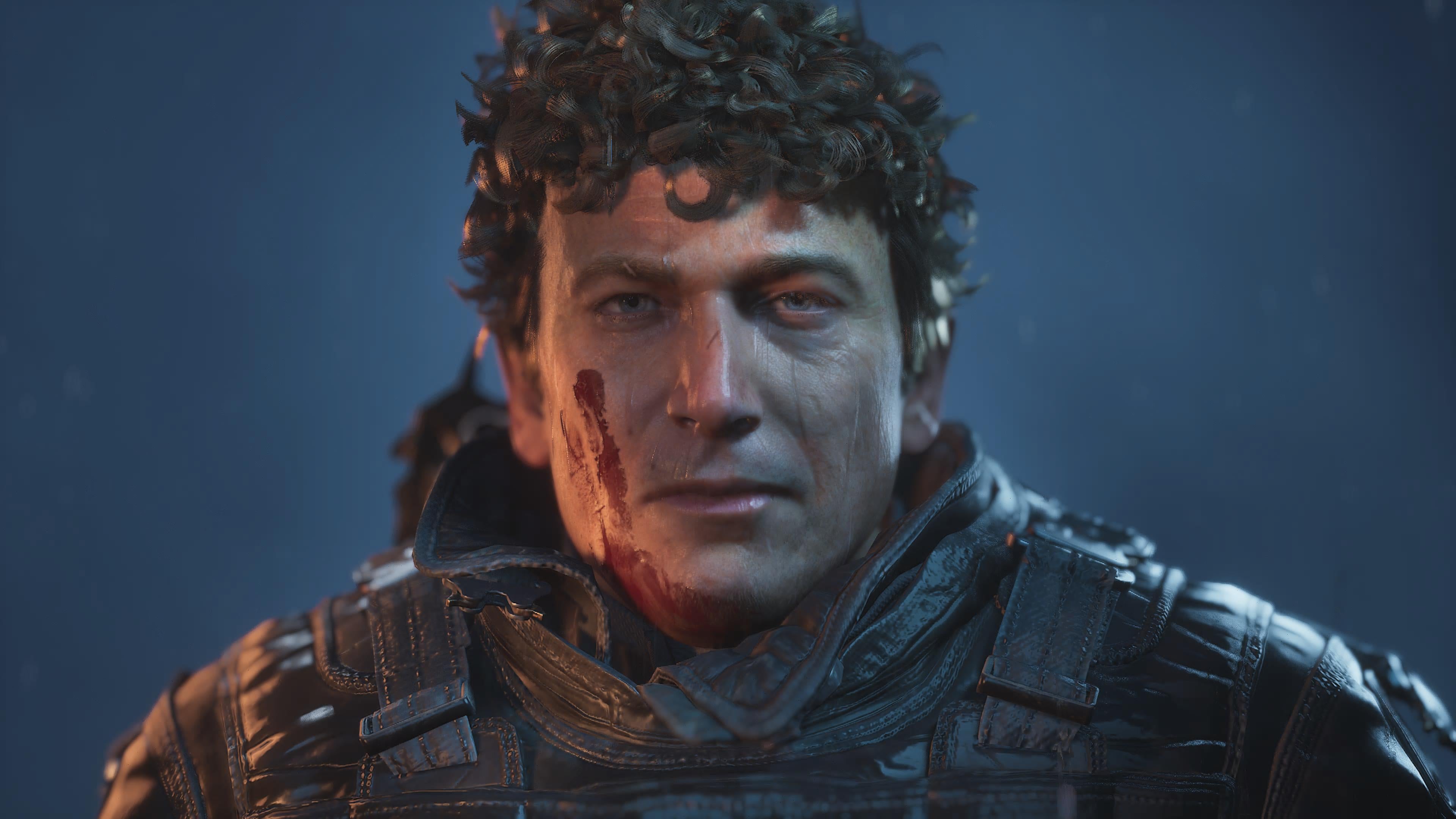Hell is Us review - nightmarish adventure treads a fine line between cryptic and tedious

Strange synths rumble and whir in an electronic hum. Wind chimes tinkle. An unearthly screech in the distance and the bass escalates in intensity. Rain tickles the DualSense. What exactly is out there?
Hell is Us is a masterpiece in mood, and much of that comes down to its score - or, more of a soundscape, really - from composer Stephane Primeau. It lends the game such a heady, oppressive atmosphere. It comes as no surprise, since Primeau was previously in a metal band; the music is dark, haunting, unsettling. I recommend playing with headphones.
That sonic tone is fitting for an adventure game exploring the cyclical nature of war. Hell is Us, as the title suggests, is a nightmare. Demonic entities shift across muddy trenches and urban streets licked by flames; tanks lay abandoned half-submerged in marshy wasteland; and innocent (or sometimes not so innocent) citizens are caught in the crossfire of a country wracked by civil war and supernatural forces.
Yet, as a result of bold design decisions by developer Rogue Factor, Hell is Us is at times a mapless nightmare of abstruse puzzles, confusing menus and shallow combat that, collectively, is hostile to play. Hostility isn't a bad thing - especially for a game depicting such a combative, malicious world - but there's a fine line between cryptic and tedious that the studio doesn't always balance. There are shades of sci-fi Zelda and classic survival horror in Hell is Us: dungeons to explore, idiosyncratic puzzles to solve, and centuries-old mysteries to unravel. Coupled with that oppressive atmosphere, it's a welcome experience that has all the makings of a cult classic. But I believe it may prove too divisive for some.
Hell is Us - Story Trailer | PS5 Games Hell is Us - Story Trailer | PS5 GamesWatch on YouTubeAfter a story-in-a-story introduction, you're dropped into the country of Hadea, a world heavily influenced by the 90s through character costumes, the low-fi computer vibes of its menus, and a ravaged landscape seemingly inspired by wars in Bosnia and Kosovo, as well as more recent conflicts in Ukraine and Gaza. Hadea is split between two religions - the Sabinians and the Palomists - that have caused suffering for centuries, but more recently ghostly creatures have appeared in the wake of civil war. Protagonist Remi is on a simple mission to infiltrate Hadea in search of his family, but is soon sucked into the country's enigmatic past.
In short, Hell is Us is a meditation on the horrors and futility of war, and how history inevitably repeats itself. The use of imagery from modern - and very current - warfare lends the game shocking relevance, in addition to its sombre, disturbing tone. On his journey, Remi meets characters on all sides - religious zealots, soldiers, desperate refugees, innocent bystanders telling stories of regular people committing horrendous feats - but never takes a stance. There are good and bad people everywhere and, in this brutal war, no winners or losers: everyone suffers, everyone deserves assistance. Hell is - obviously enough - humanity, but more specifically the media and politicians with their propaganda and "constant campaign of dehumanising the other side", as one character puts it. And when humanity has sinned and hatred of others is an embedded sickness, this war-torn hell is inescapable.
You'll meet some interesting and unsavoury characters on all sides and there's a smart conversation system that slowly unlocks new responses | Image credit: Rogue Factor / EurogamerThrough detailed character conversations and well-written clippings and recordings, Remi pieces together the storied world of Hadea that thoroughly intrigues. The issue with the plot, though, is Remi himself. Besides searching for his family, he prescribes to the "boring white guy in a jacket" school of protagonists. He barely speaks, despite being voiced by Elias Toufexis of Deus Ex fame, and rarely comments on his discoveries. He is a thoroughly uninteresting character, exploring an interesting world. There's potential to really interrogate the themes of the narrative, but Remi is little more than an avatar with whom to collect keys and hit things.
I'm being purposefully facetious here, as gameplay in Hell is Us is riveting and progress organic. Rogue Factor has chosen not to include signposting and not to provide a map, meaning players must use visual and audio clues to explore each individual zone, listen carefully to conversations, and sniff out potential leads to reveal new areas and progress the story. I love this! From the off I was utterly absorbed in Hadea, with this design choice forcing me to play in a far more attentive way than usual, focused deeply on each detail, and appreciating more thoroughly its dedication to mood. For the most part, each zone is designed to draw attention in a manageable way, though it can feel overwhelming.
The lack of map becomes more of an issue during dungeons. These take the form of underground crypts, ancient temples, scientific facilities, and more, each with their own distinct visual tone and colour palette. They're often labyrinthine and filled with locked pathways and bizarre puzzles to solve, and mostly they're satisfying to explore. Imagine for a second, though, navigating through a Zelda dungeon or the Spencer Mansion from Resident Evil with all its odd keys and locks and repetitive hallways, but not having a map to refer to and remind yourself what you found and where. That's what playing Hell is Us feels like, and while I welcomed the cognitive challenge, I did sometimes feel frustrated - as I suspect many players will.
This is all the help you get on side quests in the menu | Image credit: Rogue Factor / EurogamerThe poor UI and menu, however, are more unforgivable. Simply put, Hell is Us demands players hold far too much information in their heads. From environment layouts, to details in notes, to what the hell is this random locker key I've just picked up and where exactly am I meant to use it? The UI does a limited job of listing your findings unfiltered, and I wasted time scrolling through bits of evidence to find a hint of a code needed, or some other miniscule detail. Take my advice: play with a pen and paper, it'll be much less infuriating.
Too often, Rogue Factor's decision to withhold information results in frustration and tedium. Take side quests, or Good Deeds as they're known. These commence during specific conversations, or sometimes by collecting an item with little context. Then, they're listed deep in a menu with a blurred image and a quest title and nothing else. Unlike main missions, which are smartly organised in branching mind maps and found evidence, Good Deeds are presented minimally. What's worse, some are failable if not completed in certain, unexplained, time periods - I managed to fail every failable quest in my playthrough by repeatedly being in the wrong place at the wrong time. I appreciate the developers likely want players to think carefully on their actions and share clues with others, but the tedious nature of these quests had the opposite effect. I simply stopped caring. Still, when I randomly entered an area only to find I'd failed a mission with no reasoning, it remained disheartening.
The dungeons are a real highlight of the game | Image credit: Rogue Factor / EurogamerThen there are Timeloops - shimmering domes found in each zone of the world. These are literal embodiments of the narrative's core themes, containing ghostly apparitions of traumatic events that endlessly repeat. They're a clever marriage of plot and gameplay, and closing them is a key part of the game. You need to kill many enemies hidden in each zone, before entering the Timeloop to close it using a specific prism item. Thing is, there are three different types of prism item, but you'll only know which is needed once you actually need it. And where will you find these prisms? No idea - they could be anywhere in the world, in chests or elsewhere. While I'm at it, why can't I use an item from the inventory system but instead have to laboriously equip it to my loadout first?
Here, the game feels less cleverly cryptic, more insufficiently optimised. Many of these tasks are optional, sure, and the main quest itself is comprehensive and (for me) intellectually challenging. It had me up late at night, sat in the dark, feeling enraptured and gripped by this evocative world. At least, until its anticlimactic finale.
The rewards for side quests are usually items and buff-providing glyphs to be used in combat. But combat itself is disappointingly shallow, making those rewards redundant. It's been described as "Soulslike", but that feels like a misnomer here (beyond it being third-person and using a stamina gauge). There is a fun twist in the game's Healing Pulse ability, which feels like a mix of Nioh's Ki Pulse and Bloodborne's Rally system whereby hitting enemies releases particles that form a ring around Remi - time your button press correctly, and you'll restore health in relation to damage dealt. Combat can be punishing too, with damage received dropping both maximum health and stamina that can make recovery tricky. Any other connection to FromSoftware's work is loose.
Combat lacks depth and ultimately becomes tiresome | Image credit: Rogue Factor / EurogamerThere are four weapon types - sword, twin axes, polearm, and greatsword - each with their own attack patterns, which lends each a distinct combat rhythm when combined with the Healing Pulse. And each can be customised with an element based on differently coloured human emotions, as well as buffs and abilities specific to that emotion - though any form of rock-paper-scissors elemental system isn't explicit and lacks depth. Remi is also equipped with a drone that can provide extra support as new abilities are discovered, which are fun enough to experiment with, but as a whole combat quickly becomes monotonous and lacks the intellectual challenge of puzzle solving.
The real issue is that there are only a handful of enemy types repeated throughout the entire game, bolstered by three levels of difficulty. Some are linked to coloured Haze enemies that must be defeated first, but these abstract apparitions have such bizarre animations it's hard to get a handle on parrying their attacks appropriately. Add in a dodge that pivots around enemies rather than to the sides, and it's all too easy to be embarrassingly surrounded and stuck in a corner. Moreover, Hell is Us only has a couple of bosses - if you can even describe these unique, puzzle-like encounters as such - so there's little escalation to combat, or real tests to punctuate the flow of gameplay. As a result, combat feels repetitive and laborious when instead you're desperately trying to remember who you're trying to speak with, or where the hell was that random, locked door at the start of the game I can't remember now I'm twenty hours in and have no map to refer to.
Hell is Us features some moments of quiet beauty among its disturbing war imagery | Image credit: Rogue Factor / EurogamerDespite these misgivings, I still found Hell is Us to be a gripping experience. For each time I failed a quest or struggled to remember a vital clue, I was exploring a townscape freshly covered by the hazy, luminous glow of exploded bombs and littered with bodies frozen in death; or unearthing a medieval tomb filled with godly, mystical secrets; or investigating a strange facility as emergency signals whir and the screams of trapped humans haunt the metallic hallways. Hell is Us absolutely thrives on its atmosphere and sense of discovery, which few games nowadays even attempt in quite this manner.
I commend Rogue Factor for its design decisions, however divisive they may be. The studio has a core vision for Hell is Us, and the result is a singular experience that's as enticing as it is frustrating. Try it - this hell might just be for you.
A copy of Hell is Us was provided for review by Nacon.













